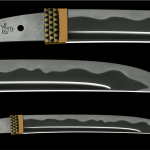
“I sometimes have to go through the hell to pursue the ultimate sword,” says master sword smith Akihira, one of roughly 10 active sword smiths and the most passionate. Unlike most of the other living sword smiths, he began honing his skills at the age of 25, after graduating from college and working some years as a salesperson.
He was bestowed the name ‘Akihira’ from his master after completing his 5-year apprenticeship. Akihira opened his own smithy immediately after gaining independence, unusual for young sword smiths. Many newly-minted sword smiths stay at their master’s place for some years as it is often difficult to find new clients. Serving as an apprentice is never easy, but through hard work Akihira was able to quickly hone his craft and draw the clients needed to Read More

